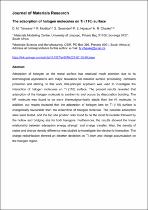JavaScript is disabled for your browser. Some features of this site may not work without it.
- ResearchSpace
- →
- Research Publications/Outputs
- →
- Journal Articles
- →
- View Item
| dc.contributor.author |
Tshwane, David M

|
|
| dc.contributor.author |
Modiba, Rosinah

|
|
| dc.contributor.author |
Govender, Gonasagren

|
|
| dc.contributor.author |
Ngoepe, PE

|
|
| dc.contributor.author |
Chauke, R

|
|
| dc.date.accessioned | 2023-03-06T08:49:21Z | |
| dc.date.available | 2023-03-06T08:49:21Z | |
| dc.date.issued | 2021-01 | |
| dc.identifier.citation | Tshwane, D.M., Modiba, R., Govender, G., Ngoepe, P. & Chauke, R. 2021. The adsorption of halogen molecules on Ti (110) surface. <i>Journal of Materials Research.</i> http://hdl.handle.net/10204/12643 | en_ZA |
| dc.identifier.issn | 0884-2914 | |
| dc.identifier.issn | 2044-5326 | |
| dc.identifier.uri | DOI:10.1557/s43578-021-00106-8 | |
| dc.identifier.uri | http://hdl.handle.net/10204/12643 | |
| dc.description.abstract | Adsorption of halogen on the metal surface has received much attention due to its technological applications and major relevance for material surface processing, corrosion protection and etching. In this work, first-principle approach was used to investigate the interaction of halogen molecules on Ti (110) surface. The present results revealed that adsorption of the halogen molecule is exothermic and occurs by dissociation bonding. The HF molecule was found to be more thermodynamically stable than the HI molecule. In addition, our results revealed that the adsorption of halogen ions on Ti (110) surface is energetically favourable than the adsorption of halogen molecule. The possible adsorption sites were tested, and the top site position was found to be the most favourable followed by the hollow and bridging site for both halogens. Furthermore, the results showed the linear relationship between adsorption energy strength and charge transfer. Also, the density of states and charge density difference was studied to investigate the electronic interaction. The charge redistribution showed an electron depletion on Ti atom and charge accumulation on the halogen region. | en_US |
| dc.format | Abstract | en_US |
| dc.language.iso | en | en_US |
| dc.relation.uri | https://link.springer.com/article/10.1557/s43578-021-00106-8#citeas | en_US |
| dc.relation.uri | https://rdcu.be/c6Xvs | en_US |
| dc.source | Journal of Materials Research | en_US |
| dc.subject | Halogen adsorption | en_US |
| dc.subject | Halogen molecules | en_US |
| dc.subject | Ti (110) surface | en_US |
| dc.title | The adsorption of halogen molecules on Ti (110) surface | en_US |
| dc.type | Article | en_US |
| dc.description.pages | 10pp | en_US |
| dc.description.note | Copyright: © The Author(s), under exclusive license to The Materials Research Society 2021. A free full-text version of the article can be viewed at https://rdcu.be/c6Xvs | en_US |
| dc.description.cluster | Manufacturing | en_US |
| dc.description.impactarea | Powder Metallurgy Technologies | en_US |
| dc.description.impactarea | Advanced Casting Technologies | en_US |
| dc.identifier.apacitation | Tshwane, D. M., Modiba, R., Govender, G., Ngoepe, P., & Chauke, R. (2021). The adsorption of halogen molecules on Ti (110) surface. <i>Journal of Materials Research</i>, http://hdl.handle.net/10204/12643 | en_ZA |
| dc.identifier.chicagocitation | Tshwane, David M, Rosinah Modiba, Gonasagren Govender, PE Ngoepe, and R Chauke "The adsorption of halogen molecules on Ti (110) surface." <i>Journal of Materials Research</i> (2021) http://hdl.handle.net/10204/12643 | en_ZA |
| dc.identifier.vancouvercitation | Tshwane DM, Modiba R, Govender G, Ngoepe P, Chauke R. The adsorption of halogen molecules on Ti (110) surface. Journal of Materials Research. 2021; http://hdl.handle.net/10204/12643. | en_ZA |
| dc.identifier.ris | TY - Article AU - Tshwane, David M AU - Modiba, Rosinah AU - Govender, Gonasagren AU - Ngoepe, PE AU - Chauke, R AB - Adsorption of halogen on the metal surface has received much attention due to its technological applications and major relevance for material surface processing, corrosion protection and etching. In this work, first-principle approach was used to investigate the interaction of halogen molecules on Ti (110) surface. The present results revealed that adsorption of the halogen molecule is exothermic and occurs by dissociation bonding. The HF molecule was found to be more thermodynamically stable than the HI molecule. In addition, our results revealed that the adsorption of halogen ions on Ti (110) surface is energetically favourable than the adsorption of halogen molecule. The possible adsorption sites were tested, and the top site position was found to be the most favourable followed by the hollow and bridging site for both halogens. Furthermore, the results showed the linear relationship between adsorption energy strength and charge transfer. Also, the density of states and charge density difference was studied to investigate the electronic interaction. The charge redistribution showed an electron depletion on Ti atom and charge accumulation on the halogen region. DA - 2021-01 DB - ResearchSpace DP - CSIR J1 - Journal of Materials Research KW - Halogen adsorption KW - Halogen molecules KW - Ti (110) surface LK - https://researchspace.csir.co.za PY - 2021 SM - 0884-2914 SM - 2044-5326 T1 - The adsorption of halogen molecules on Ti (110) surface TI - The adsorption of halogen molecules on Ti (110) surface UR - http://hdl.handle.net/10204/12643 ER - | en_ZA |
| dc.identifier.worklist | 24213 | en_US |






